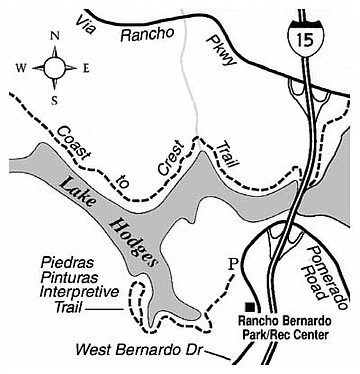 Facebook
Facebook
 X
X
 Instagram
Instagram
 TikTok
TikTok
 Youtube
Youtube
Just south of today's city of Escondido a lazy river once ran, fed by tentacle-like tributaries that drew water from as far away as the desert-bordering mountains, several days journey to the east. On the banks of this river dozens of kinds of wild plants grew, providing the prehistoric Kumeyaay people with food, fiber, and medicine.
Some of these plants were deliberately cultivated; others were suppressed through controlled burns and other means. Many were simply left undisturbed to thrive or to fail under the pressures of natural selection. Small game was hunted and captured amid the rocky hills. Fine-grained, river-bottom soil was collected for use in making clay pottery. Pigments fashioned from soluble minerals, wild seeds, and insects were carefully applied to the surfaces of large hillside boulders. The geometrical, abstract designs of the resulting pictographs expressed the ritual and ceremonial practices of the Kumeyaay.
Fast-forward hundreds of years to 2006. Place yourself on the high point of the San Dieguito River Park's Piedras Pintadas Interpretive Trail. Down below, where willows once swayed on the soggy banks of the river and smoke from cooking fires rose, a smooth sheet of water spreads wide, impounded by the Lake Hodges dam a few miles to the west. Off in the distance, a muffled roar emanates from ever-wider Interstate 15, and a carpet of winding streets and homes creeps over the hills and dales of Escondido and Rancho Bernardo. Hidden above the trail, on boulder-studded slopes guarded by thickets of chaparral, the Kumeyaay pictographs slowly fade under the imperceptibly slow onslaught of solar radiation, acidic rainfall, and drying winds.
Today, while the Kumeyaay rock-art site is officially off-limits to visitation, you can stroll the nearby trail, designed to educate and inform the public. You'll get the equivalent of a small book's worth of historical, cultural, and botanical information if you stop to read each of the many plaques scattered along the trailside.
The 3.8-mile, looping Piedras Pintadas Trail departs from a trailhead on West Bernardo Road, just south of Lake Hodges and across the street from a large retirement complex. (Note that due to the current widening project on I-15, the West Bernardo overpass was recently demolished, and there will be no access from I-15 northbound to West Bernardo Road until next year.) The trail can be covered on foot in an hour at a speed-walking pace, or in two hours if you care to read every interpretive panel. Mountain bikers are allowed on the trail, and leashed dogs are welcome. Free guided hikes are offered on some weekends; call 858-674-2270 for more information.


Just south of today's city of Escondido a lazy river once ran, fed by tentacle-like tributaries that drew water from as far away as the desert-bordering mountains, several days journey to the east. On the banks of this river dozens of kinds of wild plants grew, providing the prehistoric Kumeyaay people with food, fiber, and medicine.
Some of these plants were deliberately cultivated; others were suppressed through controlled burns and other means. Many were simply left undisturbed to thrive or to fail under the pressures of natural selection. Small game was hunted and captured amid the rocky hills. Fine-grained, river-bottom soil was collected for use in making clay pottery. Pigments fashioned from soluble minerals, wild seeds, and insects were carefully applied to the surfaces of large hillside boulders. The geometrical, abstract designs of the resulting pictographs expressed the ritual and ceremonial practices of the Kumeyaay.
Fast-forward hundreds of years to 2006. Place yourself on the high point of the San Dieguito River Park's Piedras Pintadas Interpretive Trail. Down below, where willows once swayed on the soggy banks of the river and smoke from cooking fires rose, a smooth sheet of water spreads wide, impounded by the Lake Hodges dam a few miles to the west. Off in the distance, a muffled roar emanates from ever-wider Interstate 15, and a carpet of winding streets and homes creeps over the hills and dales of Escondido and Rancho Bernardo. Hidden above the trail, on boulder-studded slopes guarded by thickets of chaparral, the Kumeyaay pictographs slowly fade under the imperceptibly slow onslaught of solar radiation, acidic rainfall, and drying winds.
Today, while the Kumeyaay rock-art site is officially off-limits to visitation, you can stroll the nearby trail, designed to educate and inform the public. You'll get the equivalent of a small book's worth of historical, cultural, and botanical information if you stop to read each of the many plaques scattered along the trailside.
The 3.8-mile, looping Piedras Pintadas Trail departs from a trailhead on West Bernardo Road, just south of Lake Hodges and across the street from a large retirement complex. (Note that due to the current widening project on I-15, the West Bernardo overpass was recently demolished, and there will be no access from I-15 northbound to West Bernardo Road until next year.) The trail can be covered on foot in an hour at a speed-walking pace, or in two hours if you care to read every interpretive panel. Mountain bikers are allowed on the trail, and leashed dogs are welcome. Free guided hikes are offered on some weekends; call 858-674-2270 for more information.
